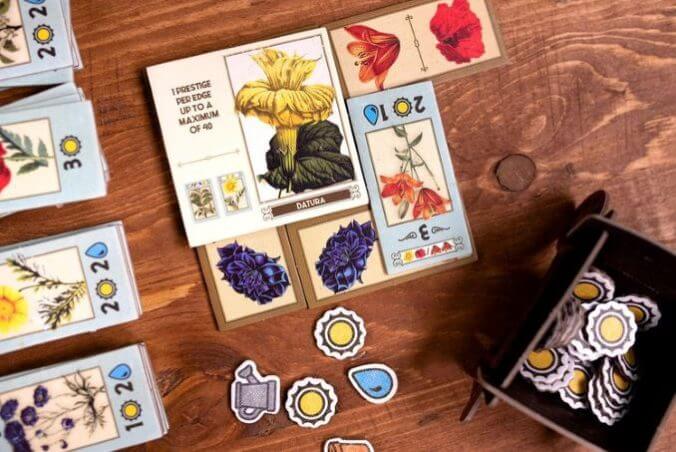Sowing the Seeds of Victory with the Great Gartenbau

Many of the best games I’ve played work with a simple set of rules that create many different decisions for players to make, whether it’s differing strategies to win or tight individual decisions for each turn. Gartenbau, a new game from designers David Abelson and Alex Johns, fits that archetype perfectly: There are just a few rules, players have a short list of potential actions on each turn, but the decisions you have to make on each turn and for the entire game are tight and intense.
Gartenbau takes its theme from an old-timey flower show, as players try to build plants in specific pairs to cover them with larger flower tiles that will provide the majority of the game-end victory points. Players place tiles in three layers–seedlings, plants, flowers–and try to match patterns in the seedling and then plant layers to satisfy the conditions in the tiles that will go on top. Seedlings and plants are domino-shaped, 2×1, while flowers are 2×2.
On your turn, you can do one of just four things: take a seedling, buy a plant, place a flower tile, or take resources. The central board has a rondel that players move around to select the top seedling tile from the next closest unoccupied stack, or can move further by paying one resource for each stack they skip. A player can also move to the next unoccupied stack and take the resources shown next to it–sun, water, or a combination of both–instead of taking a seedling.
In between those stacks are open spaces where players can move when they want to buy a plant from the supply or place one of their flowers. There are six types of plants in the game, and each must be placed on a specific combination of two seedling symbols on tiles already in your tableau–and those symbols must be on two different, adjacent seedling tiles. The seedling tiles are free, but where you place them and when you acquire them turns out to be incredibly important–or limiting–for later in the game. Each plant has a victory point value, and whenever a player buys a plant tile from a stack, the next tile costs more resources, and may be worth one more victory point as well.
If you place a pair of plants next to each other that match the criteria for one of your five flowers, you can place that flower, covering up the plants (and their victory points) to instead score the victory points on the flower. Some flowers give a flat VP bonus of up to 20 points, while others offer variable bonuses such as points based on the number of orange flowers/seedlings showing anywhere in your tableau, or points for “holes” you’ve created within your tableau by surrounding open spaces with seedling tiles. The game comes with starter sets of five flowers, or you can draft using the full set of flowers that include some more advanced scoring options. When you place any flower, you also get a one-time bonus of three resources of your choice.
